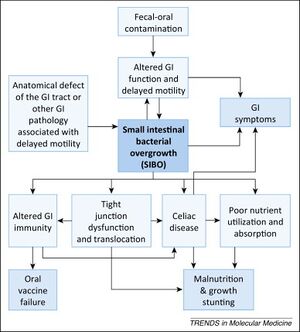Small Intestinal Bacterial Overgrowth: Difference between revisions
No edit summary |
|||
| Line 33: | Line 33: | ||
==Medical Management of SIBO== | ==Medical Management of SIBO== | ||
Unfortunately, the current management of SIBO is unclear. <ref name =“Bohm”></ref> Common management strategies include using antibiotics | Unfortunately, the current management of SIBO is unclear. <ref name =“Bohm”></ref> Common management strategies include using antibiotics | ||
Research also proposes dietary changes to help relieve the functional gastrointestinal (GI) symptoms. <ref name=”Gibson”> [https://doi.org/10.1038/ajg.2012.49. Gibson, Peter R, and Susan J Shepherd. “Food Choice as a Key Management Strategy for Functional Gastrointestinal Symptoms.” American Journal of Gastroenterology, vol. 107, no. 5, 2012, pp. 657–666., https://doi.org/10.1038/ajg.2012.49. ] </ref> Reduce intake of FODMAPs (fermentable oligo-, di-, and mono-saccharides and polyols)—poorly absorbed short-chain carbohydrates can effectively reduce bloating and other functional gastrointestinal symptoms. <ref name=”Gibson”></ref> Other food sources of functional gastrointestinal symptoms including gluten and natural and added food chemicals such as amines and glutamates and the benefit of dietary strategies that reduce the intake of these chemicals are still being researched. <ref name=”Gibson”></ref> | |||
==Interactions Between SIBO and Other Systemic Conditions== | ==Interactions Between SIBO and Other Systemic Conditions== | ||
Revision as of 16:22, 7 December 2022
Overview
Small intestinal bacterial overgrowth (SIBO) is defined as the abnormal increase in the overall bacterial population in the small intestine. [1] Common symptoms of SIBO include diarrhea, flatulence, abdominal pain and bloating. [2] [3]Currently there is no single valid test for SIBO, but common ways of screening for SIBO include small-bowel aspiration and quantitative culture and breath testing. [4]
SIBO was first suggested by Barker and Hummel in their 1939 publication “Macrocytic anemia in association with intestinal strictures and anastomoses.”, providing key findings for both the study of Macrocytic anemia and the study of SIBO. [5]

At right is a sample image insertion. It works for any image uploaded anywhere to MicrobeWiki. The insertion code consists of:
Double brackets: [[
Filename: PHIL_1181_lores.jpg
Thumbnail status: |thumb|
Pixel size: |300px|
Placement on page: |right|
Legend/credit: Electron micrograph of the Ebola Zaire virus. This was the first photo ever taken of the virus, on 10/13/1976. By Dr. F.A. Murphy, now at U.C. Davis, then at the CDC.
Closed double brackets: ]]
Other examples:
Bold
Italic
Subscript: H2O
Superscript: Fe3+
Testing for SIBO
Medical Management of SIBO
Unfortunately, the current management of SIBO is unclear. [6] Common management strategies include using antibiotics
Research also proposes dietary changes to help relieve the functional gastrointestinal (GI) symptoms. [7] Reduce intake of FODMAPs (fermentable oligo-, di-, and mono-saccharides and polyols)—poorly absorbed short-chain carbohydrates can effectively reduce bloating and other functional gastrointestinal symptoms. [7] Other food sources of functional gastrointestinal symptoms including gluten and natural and added food chemicals such as amines and glutamates and the benefit of dietary strategies that reduce the intake of these chemicals are still being researched. [7]
Interactions Between SIBO and Other Systemic Conditions
Include some current research, with a second image.
<be>
Conclusion
Overall text length (all text sections) should be at least 1,000 words (before counting references), with at least 2 images.
Include at least 5 references under References section.
References
- ↑ “Small Intestinal Bacterial Overgrowth (SIBO).” Mayo Clinic, Mayo Foundation for Medical Education and Research, 6 Jan. 2022, https://www.mayoclinic.org/diseases-conditions/small-intestinal-bacterial-overgrowth/symptoms-causes/syc-20370168.
- ↑ Sachdev, Amit H, and Mark Pimentel. “Gastrointestinal bacterial overgrowth: pathogenesis and clinical significance.” Therapeutic advances in chronic disease vol. 4,5 (2013): 223-31. doi:10.1177/2040622313496126
- ↑ Bohm, Matthew, et al. “Diagnosis and Management of Small Intestinal Bacterial Overgrowth.” Nutrition in Clinical Practice, vol. 28, no. 3, 2013, pp. 289–299., https://doi.org/10.1177/0884533613485882.
- ↑ Saad, Richard J., and William D. Chey. “Breath Testing for Small Intestinal Bacterial Overgrowth: Maximizing Test Accuracy.” Clinical Gastroenterology and Hepatology, vol. 12, no. 12, 2014, pp. 1964–1972., https://doi.org/10.1016/j.cgh.2013.09.055.
- ↑ Barker, W. H., and L. E. Hummel. "Macrocytic anemia in association with intestinal strictures and anastomoses." Bull Johns Hopkins Hosp 64.2 (1939): 15.
- ↑ Cite error: Invalid
<ref>tag; no text was provided for refs named“Bohm” - ↑ 7.0 7.1 7.2 Gibson, Peter R, and Susan J Shepherd. “Food Choice as a Key Management Strategy for Functional Gastrointestinal Symptoms.” American Journal of Gastroenterology, vol. 107, no. 5, 2012, pp. 657–666., https://doi.org/10.1038/ajg.2012.49.
Edited by Yufan Lu, student of Joan Slonczewski for BIOL 116 Information in Living Systems, 2022, Kenyon College.
